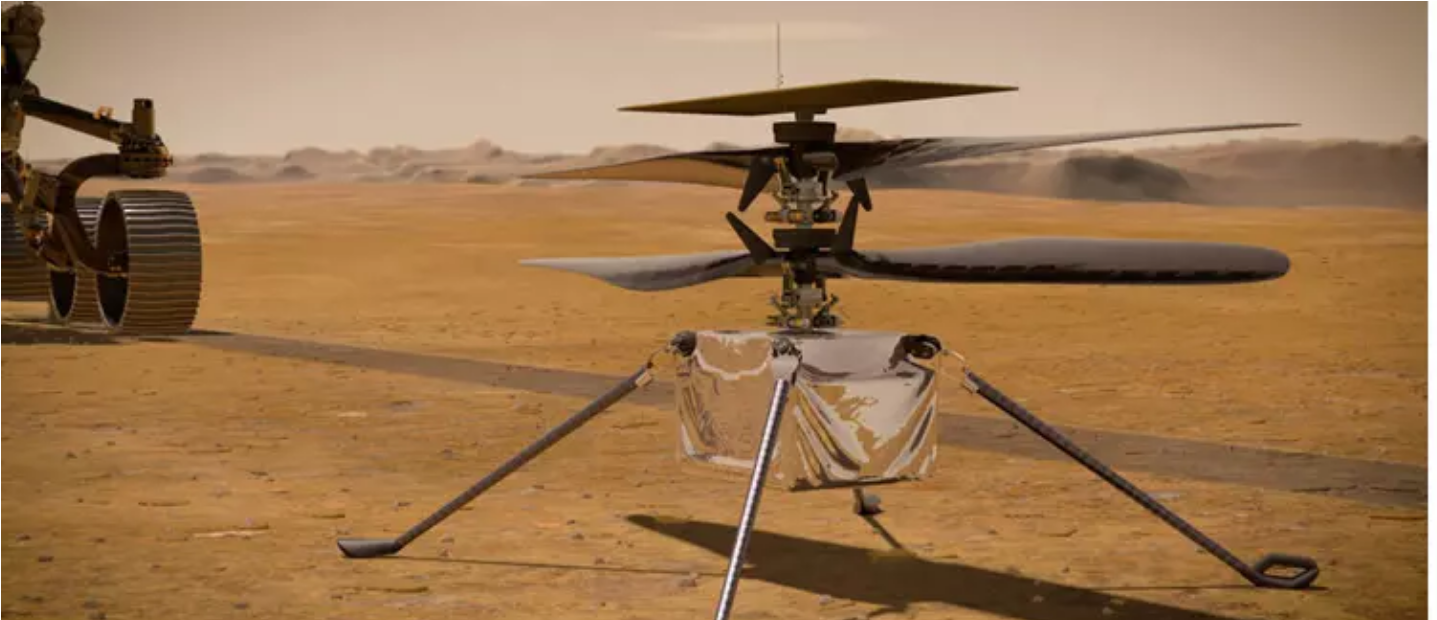- 2-way dialogue and strong collaboration between the public and private sectors must happen early and continuously in the development process.
- Work between NASA’s Jet Propulsion Laboratory (JPL) and Qualcomm Technologies Inc., led to Ingenuity, a small helicopter drone that landed on Mars on February 18th, 2021 and is the first autonomous aerial platform operated outside Earth’s atmosphere.
- The collaboration between JPL and Qualcomm Technologies, Inc. helped shorten the innovation cycle by 15 years.
Since July, a small helicopter drone named Ingenuity had been hitched to the underbelly of the Perseverance rover as it made its way to Mars. The drone’s arrival this February marked the first time an autonomous aerial platform is operated outside Earth’s atmosphere.
The drone was also the first to be used in space science exploration – and other firsts will likely follow. Ingenuity’s planned experiential flights on Mars will aim to prove the effectiveness of aerial exploration for future interplanetary missions to scout areas once considered out of sight and reach.
The project – like any other scientific advancement – leverages decades of scientific expertise. But the drone, based on Qualcomm’s Snapdragon Flight platform, also leverages private sector knowledge and guidance. This advancement would not have been possible unless the two core collaborators – NASA and Qualcomm Technologies – had not connected at the right time and in the right way. https://www.youtube.com/embed/4czjS9h4Fpg?enablejsapi=1&wmode=transparent
The challenge
To fully understand the scientific achievement Ingenuity represents, it’s necessary to detail the challenges that Mars exploration presents. First, Mars’ atmosphere is 99% less dense than Earth’s, which means achieving lift is very difficult. Second, because of the time it takes for communication signals to pass between Earth and Mars – anywhere from 3 to 22 minutes – remote controlled flight is not possible.
To enable this mission in the face of these challenges, Ingenuity required high computational performance at extremely low power for autonomous navigation via computer vision, intelligent decision making, and a small, lightweight design. Such a project required not just NASA’s expertise in space science exploration but also required knowledge of cutting-edge technologies. These technologies included flight navigation based on computationally complex flight algorithms and a rich array of computer vision enablement technologies for drone location determination and object avoidance, something only a private sector company could provide.
The collaboration
NASA’s Jet Propulsion Laboratory (JPL) approached Qualcomm Technologies, Inc. (QTI) in 2015 as the Qualcomm Snapdragon Flight platform was being developed. The Flight Platform was designed to enable drone manufacturers to build drone platforms quickly and efficiently.
These specifications fit with JPL’s needs: a commercial-based platform with the correct size and power constraints that could manage flight, control, and the ability to take and store images that would ultimately prove the utility of drones on another planet for the betterment of space science.
Through this process, it became evident that the autonomous capabilities Qualcomm was commercializing for next generation automotive experiences were in lockstep with the mission requirements JPL was seeking for aerial space exploration and that QTI could understand its program objectives. As a result, QTI was brought on as a consult to act as a sounding board while JPL was integrating a solution.
Several factors led to the successful partnership, revealing elements any collaborators in the public and private sector could put into place. They include:
- Starting early. Such early and continuous connections were key. Leveraging commercial technology must be strategic. During this critical early period, core technologies are developed, standards are created, and rollout plans are shaped. When the right experts can connect early in the process, the right technologies can be applied to the right mission needs.
- Open communication. Bringing two partners together isn’t guaranteed to lead to innovation. Open communication is required. In this case, the collaboration included a two-way exchange of ideas and education of the two very different worlds – the public and private sector – each with its unique way of solving complex mission problems.
This two-way engagement enabled QTI and JPL to take an empathetic view that unified their collective thinking toward a common goal. Early open discussions and brainstorming sessions revealed how commercial technology could best address mission specifications. By focusing on the needs of the mission, the teams could guide one another through in-person visits early on. Later, a cadence of collaboration via teleconference and email was created to help answer questions as they arose. - Continuous partnership. Qualcomm now continues to collaborate on this project while Perseverance and Ingenuity make their first explorations on Mars. This proves another key aspect of a successful partnership. Engagement cannot be ‘one and done’ – it must be continual, ensuring that the key collaborators can keep problem solving through different phases of development.
The way forward
Conventional wisdom suggests that public sector and private sector ecosystems are vastly different in structure, composition, language and priorities. Common ground can be found, however, because many of the problems each ecosystem tries to solve for its constituents are often remarkably similar.
"Engagement cannot be ‘one and done’ – it must be continual, ensuring that the key collaborators can keep problem solving through different phases of development." —Kim Koro, Senior Vice President, Qualcomm Technologies, Inc. and President, Qualcomm Government Technologies
Still, the opportunity for public and private partnerships isn’t just to find short-term solutions that benefit both parties. As the public sector cannot match the scale at which the private industry invests in developing new capabilities, the public sector needs to find ways tap into that momentum and dynamic expertise, enabling government to move at the speed of innovation.
Governments that continually work with industry do not limit themselves to waiting for technology when it is productized and available commercially on the shelf (COTS). As this partnership with Qualcomm and JPL shows, by utilizing an early engagement point with the commercial industry, governments can dramatically shift the cycle of change and innovation. In this case, the cycle shrank from almost 20 to just 5 years.
The more the public and private sector learn how to leverage their strengths, the better technology will address existing and anticipated needs. Ingenuity provides a perfect reminder of collaborative power – a pioneering technology that’s the unique product of great minds coming together.

